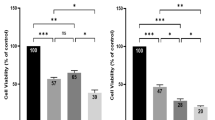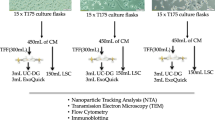Abstract
Solid tumours are known to develop regions of extracellular acidity and survival of tumour cells in such regions depends on membrane-based mechanisms which regulate intracellular pH (pHi). We have therefore developed a method, based on dual staining of cells and flow cytometry, to study the regulation of pHi in subpopulations of tumours and spheroids. The activity of membrane-based pHi regulating transporters was studied in EMT-6 and MGH U1 cells grown in monolayer culture, spheroids, and tumours. pHi was measured with the fluorescent pH probe 2'7'-bis-(2-carboxyethyl)-5-(and-6)carboxyfluorescein, and Hoechst 33342 was used to identify cells from different regions of tumours and spheroids. In monolayer culture, incubation of cells for 18 h at pHe 6.6 led to a 1.3-1.5-fold enhancement in the activity of both the Na+/H+ exchanger and the Na(+)-dependent Cl-@HCO3- exchanger. This effect was prevented by the protein synthesis inhibitor cycloheximide. Cells from the centre of EMT-6 spheroids had increased activity of the Na+/H+ exchanger compared to cells from the periphery, when spheroids were grown in medium at pH 6.6, but not at 7.4. By contrast, in MGH U1 spheroids, cells from the centre had increased activity of the Na+/H+ antiport under both sets of conditions. There was no significant difference in the activity of the Na+/H+ exchanger in cells derived from different subpopulations of EMT-6 tumours or MGH U1 xenografts in nude mice. Although upregulation of Na+/H+ exchange occurs after exposure to acidic conditions in vitro, the microenvironmental conditions found within solid tumours do not appear to cause this effect. Our results suggest the feasibility of pharmacological inhibition of Na+/H+ exchange activity as an approach to therapy directed against nutrient-deprived tumour cells.
This is a preview of subscription content, access via your institution
Access options
Subscribe to this journal
Receive 24 print issues and online access
$259.00 per year
only $10.79 per issue
Buy this article
- Purchase on Springer Link
- Instant access to full article PDF
Prices may be subject to local taxes which are calculated during checkout
Similar content being viewed by others
Author information
Authors and Affiliations
Rights and permissions
About this article
Cite this article
Boyer, M., Barnard, M., Hedley, D. et al. Regulation of intracellular pH in subpopulations of cells derived from spheroids and solid tumours. Br J Cancer 68, 890–897 (1993). https://doi.org/10.1038/bjc.1993.451
Issue Date:
DOI: https://doi.org/10.1038/bjc.1993.451
This article is cited by
-
What is the malignant nature of human ductal carcinoma in situ?
Nature Reviews Cancer (2011)
-
Modulation of tumor cell response to chemotherapy by the organ environment
Cancer and Metastasis Reviews (1994)



